#house Lothston
Explore tagged Tumblr posts
Note
Was King Maekar or any of his vassals directly involved in the downfall of House Lothston? Also, how much of Danelle's rumored dark magic was real and how much of it was misogynistic propaganda?
Long, more under the cut:
We know virtually nothing about the downfall of House Lothston, other than that “[t]heir line was ended in madness and chaos when Lady Danelle Lothston turned to the black arts during the reign of King Maekar I”. Whether King Maekar himself participated in bringing down House Lothston and raising the Whents in their place, or whether he merely oversaw a local rebellion or indirect royal response against Lady Danelle and performed the executive cleanup afterward, is impossible at this moment to say. Certainly, Harrenhal sits close enough to the border of the Crownlands that those Houses sworn directly to the crown could have participated in dethroning Danelle, either because they had a vested local interest in doing so and/or because Maekar may have seen them as a useful ready force to respond quickly. Additionally, Maekar was certainly not shy about responding personally, and especially militarily, to threats in the realm: his leadership in the First and Third Blackfyre Rebellions, his probable intervention against Dagon Greyjoy, and of course his fatal action during the rebellion at Starpike. Given that history, it’s entirely possible Maekar himself led a royal/Crownlands-supported force to depose Lady Lothston (vaguely akin to Bloodraven doing so during the events of “The Mystery Knight”). However, with the only other specific detail in the end of the Lothston line being that the Whents “were given Harrenhal as a reward for their service in bringing the Lothstons down”, this could easily have been a local rebellion led by the Lothstons’ vassals and tenants, and simply recognized afterward by the crown.
Do I think Danelle Lothston was genuinely guilty of some level of crime, possibly linked to “black arts”? I think it likely. (Which is not to say there was not also, and perhaps at the same time, misogynistic propaganda against her - more on that momentarily.) Number one, GRRM seems to have written the members of House Lothston almost uniformly negatively, or at least without much in the way of positive or heroic attributes. Danelle’s (probable) predecessors as rulers of Harrenhal, Lucas and Manfryd (or Manfred), are the most clearly villainous: Lucas infamously remembered as “the Pander” for his callous promotion of his wife and daughter as Aegon IV’s perhaps simultaneous mistresses; Manfryd decried as “Manfryd o’ the Black Hood”, marked by his vague but ominous “black deeds”. Falena, née Stokeworth, hardly comes across better, given her disturbing sexual relationship with (that is, rape of) the 14-year-old Prince Aegon; whether Falena actively encouraged the later King Aegon’s dual sexual interest, or was forced to do so by her husband, only furthers her negative characterization or adds the unfortunately familiar context of Westerosi patriarchy to the affair. Even the most sympathetic of the Lothstons, young Jeyne, seems to be presented more as an object of pity rather than as a laudable figure in her own right - a teenager used and abused by virtually (or actually) every adult in her life, then abandoned when she no longer proved useful to those adults.
While none of these figures was specifically described as using magic or “black arts”, the point of the above is to say that I think GRRM is writing the Lothstons along the same lines as, say, the Brackens or Peakes - in other words, narrative heels, almost always the villains of whatever situation the author writes for them. In light of that dynastic negativity, I could see where the author will actually have Danelle dabble in supernatural practices, given that Westeros is a world where magic, including blood magic, is real, potent, and potentially nefarious. Whatever Danelle may have wanted to gain by such magic (and the potential of sorcery in this world is too wide to speculate with any real certainty, given what little else we have on her), she was in a position where, if she so chose, she could magically exploit the resources of Harrenhal’s vast estate - the potential sorcerous knowledge its library might possess (or that she could obtain from other places), as well as the smallfolk she could summon and use - for that purpose.
Number two, I think the very obvious real-world inspiration GRRM is drawing on for Lady Danelle is Elizabeth Báthory - or, maybe more specifically, the popular conception of Elizabeth Báthory. Whatever the actual truth of her crimes, the legend of Elizabeth Báthory is one of maniacal, even supposedly supernatural bloodshed and cruelty - a sadistic, pseudo-vampiric figure who tortured and killed her young, female victims in a quest for eternal youth and beauty. As GRRM tends to rely on (often woefully inaccurate, ahem Henry VIII) popular ideas of historical figures, I think he’ll likely do the same here - not delving too deeply into research on the real-life Báthory, more simply drawing on the historical/pseudo-historical legend. Again, because this is a world where magic, including blood magic, is real, it’s even easier for GRRM to take the fantastical version of Báthory that has come down in myth and present her more literally with Danelle Lothston.
Number three, I think the idea of a malicious, and indeed feudally and sorcerously malicious, figure being brought down by the intervention of the crown under King Maekar fits so perfectly with what I see as the development of our Egg from prince into king. What Egg has begun to observe in these first three Tales of Dunk and Egg, and what I think he’ll see more and more explicitly as the Tales continue, is unchecked aristocratic privilege turned to the worst degree, especially against the smallfolk of these estates - torturing them to death for unclear crimes (as Dunk sees in the opening of “The Sworn Sword”), placing them in the bloody middle of their highborn feuds (as I think we’ll read about, quite literally, in “The Village Hero”), or simply letting them suffer without the expected protection of their overlords while those lieges squabble over titles and position (which I think will be a major issue in whatever “The She-Wolves of Winterfell” ends up being called). Lady Danelle being guilty of at least some level of crime, and perhaps blood magic-based crime, against her people would escalate this issue even more for Egg: here was a great local magnate who, despite her sometime allegiance to the crown (as seen in the Second Blackfyre Rebellion), had exercised her personal power at the cost, in blood and/or lives, of the people she was ostensibly obliged to guard and nurture - thereby proving again to Egg, perhaps, the value of promoting greater rights for the smallfolk during his eventual reign. Likewise having Egg argue, perhaps, for his father to bring down, or at least support the bringing down, of a woman who both so grossly abused her feudal responsibilities toward her people and was potentially notorious in her use of sorcery, the author may foreshadow Egg making a similar, but possibly even more dramatic, decision against Bloodraven - denouncing another sorcerer and sometime supporter of the crown who had nevertheless allowed for great suffering among the smallfolk, and who had committed too great a crime to go unpunished.
Now, again, does Lady Lothston being guilty of some level of crime mean that there is no possibility of misogyny or sexism associated with her downfall? Of course not. Indeed, the very idea that Danelle bathed in blood - a rumor very much recalling Egg’s report that Shiera Seastar “bathe[d] in blood to keep her beauty” - reflects the (male) Westerosi conception of “older” women (again, by Westerosi standards) as “handsome” rather than beautiful, and even that designation is often a concession in light of their age (see, for example, Alerie Hightower). Likewise, because Danelle was a woman ruling in her own right in a patriarchal aristocracy which expects power to flow from males, through males, to males, Danelle was from the outset subject; again, while I still think Danelle was likely guilty of some level of crime, the largely negative social conception of female rule may have formed additional, sexist context to her downfall - “if only there had been a strong male hand at Harrenhal”, for example, or “well, that’s what happens when you give a woman so much power”. (And of course, I tend to think Hoster Tully may have eyed the later female inheritance of the Lothstons’ successors at Harrenhal, the Whents, with an idea of taking advantage of similar misogynistic unease.) Too, Harrenhal’s historical association with women of allegedly maliciously supernatural reputation - Rhaena, who spent her last years at Harrenhal “feared … as a witch” by locals, and Alys Rivers, the so-called “witch queen of Harrenhal”, who held the castle in supposed draconic defiance of King Aegon III - may have again aided the potentially misogynistic context of Danelle’s downfall. Again, Danelle does not have to have been completely guiltless - Alys Rivers certainly maintained an active rebellion against the Targaryen government, and was - for her to be lumped in with the “witches” of Harrenhal’s past, and to have her crimes take on an exaggerated, sensationally supernatural nature - the stories of sending out giant bats to capture children, for instance. Danelle Lothston being guilty and Danelle Lothston being subject to misogynistic prejudices are not mutually exclusive ideas; the author’s excellent exploration of that dynamic with, say, Cersei is proof of that.
#asoiaf meta#danelle lothston#maekar i targaryen#aegon v targaryen#tales of dunk and egg#house lothston
54 notes
·
View notes
Text

Mi anciana madre me decía que, en las noches sin luna, venían de Harrenhal murciélagos gigantes y se llevaban a los niños malos para que Danelle la Loca los asara. A veces los oía arañar los postigos.
#danelle lothston#pre asoiaf#asoiaf#a song of ice and fire#asoiaf fanart#the world of ice and fire#my art digital art#house lothston#hallowen westeros of my
34 notes
·
View notes
Text
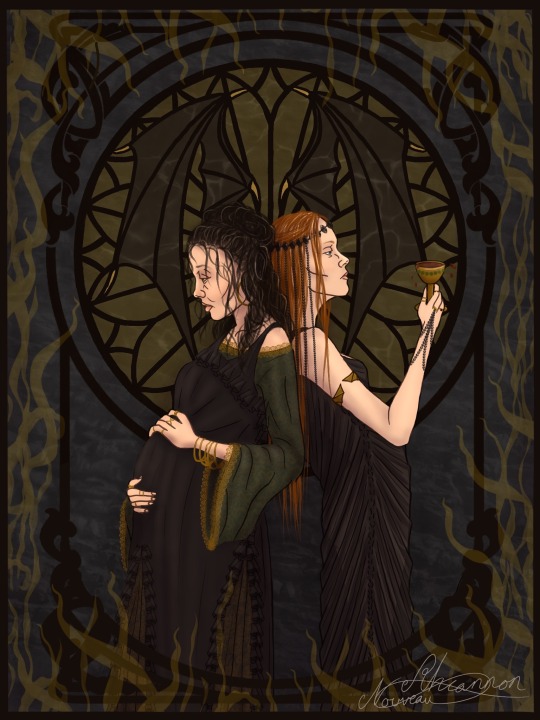
Witch queens of Harrenhal
Alys Rivers has been getting a lot of hype recently but Danelle Lothston deserves love too
#asoiaf#asoiaf art#game of thrones#hotd#house of the dragon#harrenhal#house Lothston#house strong#Alys rivers#danelle lothston
288 notes
·
View notes
Text










Posthumous Characters GIF Sets → Jeyne Lothston
Daughter of Lady Falena, the king’s first mistress, by either Lord Lucas Lothston or the king himself. Jeyne was brought to court by her mother in 178, when she was fourteen. Aegon made Lord Lothston his new Hand, and it was said (but never proved) that he enjoyed mother and daughter together in the same bed. He soon gave Jeyne a pox he’d caught from the whores he’d been seeing after Lady Bethany’s execution, and the Lothstons were then all sent from court again.
#asoiafedit#valyrianscrolls#jeyne lothston#house lothston#house targaryen#a song of ice and fire#asoiaf gifs#nanshe's graphics
22 notes
·
View notes
Text

Judith with the head of Holofernes by Louis Finson
this is sooooooooooooooo danelle lothston core
#my work#showing off her guy's head#the maidservant looking at the camera like 'can you see this shit?'#it just makes sense#danelle lothston#house lothston#asoiaf#valyrianscrolls
4 notes
·
View notes
Text
Mad Danelle Lothston BANNED from tik tok after posting her #girldinner
6 notes
·
View notes
Text
So I wrote a one-shot character study of Jeyne Lothston; please be mindful of the tags. Aegon IV is his own warning, as is Lucas Lothston.
#jeyne lothston#lucas lothston#falena stokeworth#aegon iv targaryen#house lothston#harrenhal#asoiaf fic#my fic
3 notes
·
View notes
Text
my tinfoil hat is on but how funny would it be if jeyne lothston -- rumored daughter of aegon the unworthy -- was married off to a whent and therefore the canon-era tullys already have targaryen blood so rhaegar "fulfilling the prophecy" with jon was kind of redundant? the whents were knights in service to the lothstons when they held harrenhal and we know that "dishonored" daughters of noble houses are sometimes married off to household knights which can elevate that knight's status. lollys' marriage to bronn comes to mind. this would give a bit of extra weight to brynden rivers choosing bran as his mentee, as he would also be a descendent of aegon the unworthy.
the only snag is that it is said that jeyne contracted a pox from aegon, which is why she was dismissed from his court. not sure if that would prevent her from having children. it's also always possible jeyne had a bastard by aegon that was not noted in AWOIAF but i will certainly keep my eyes peeled for houses lothston and whent's lines in blood and fire.
#valyrianscrolls#asoiaf speculation#asoiaf theory#house whent#house lothston#jeyne lothston#aegon the unworthy#blood and fire#house blackfyre#brynden rivers#king aegon iv targaryen#falena stokeworth#house tully#bran stark#house stark
1 note
·
View note
Text
Why Harrenhal is Called the Most Cursed Castle in Game of Thrones Universe https://candepie.com/why-harrenhal-is-called-the-most-cursed-castle-in-game-of-thrones-universe/
#game of thrones#house of dragons#a song of ice and fire#got#hotd spoilers#hotd#fire and blood#jon snow#danerys targaryen#harrenhal#harren hoare#aegon targaryen#aegon the conqueror#aegon's conquest#house strong#house lothston#house whent#house frey#curse of harrenhal#cursed castle#creation of harrenhal#war of the five kings#house of the dragon
0 notes
Text
Falena Stokeworth, Danelle Lothston, Jeyne Lothston

#Falena Stokeworth#Jeyne Lothston#danelle lothston#digital#game of thrones#hotd#asoiaf art#asoiaf fanart#asoiaf#got#gotfanart#house targaryen#valyrianscrolls#a song of ice and fire#digitalart#asoiaffanart#housetargaryen#housetargaryen🐲
47 notes
·
View notes
Text
Lady Jayne Lothston, eight mistress of Aegon IV and possibly his bastard with Falena Stokeworth 🌾
Art by @rozsesandart
art masterlist- kofi- commissions info- socials
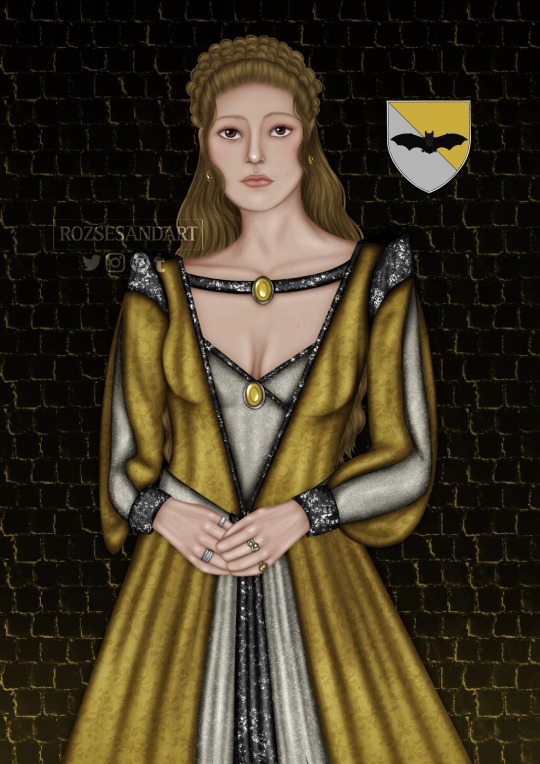

#jeyne lothston#falena stokeworth#aegon iv targaryen#aegon the unworthy#digital aritst#digital art#game of thrones#house of the dragon#game of thrones fanart#got fanart#hotd#asoiaf art#house targaryen#hotd fanart#nine mistresses#a song of ice and fire#asoiaf fanart#asoiaf#hotd season 2#hotd art#got fandom#got art#fire and blood#george rr martin#a game of thrones#fire and blood fanart#fantasy art#book characters#great bastards#digital commisions
61 notes
·
View notes
Note
Brother and sister, uncle and niece, aunt and nephew plus "cousin marriage" seem to not quick cover it when all the parents, grandparents, great-grandparents were siblings... Anyhow all those circumstances fly for the Targaryens, but just checking a son never married his mother or a daughter never married her father?
The quote from TWOIAF/F&B is:
The tradition amongst the Targaryens had always been to marry kin to kin. Wedding brother to sister was thought to be ideal. Failing that, a girl might wed an uncle, a cousin, or a nephew; a boy, a cousin, aunt, or niece. This practice went back to Old Valyria, where it was common amongst many of the ancient families, particularly those who bred and rode dragons. "The blood of the dragon must remain pure," the wisdom went. Some of the sorcerer princes also took more than one wife when it pleased them, though this was less common than incestuous marriage. In Valyria before the Doom, wise men wrote, a thousand gods were honored, but none were feared, so few dared to speak against these customs.
So no, parent/child incest is not mentioned to be a Valyrian tradition. However, there are rumors that King Aegon IV's eighth mistress, Jeyne Lothston, was actually his own daughter by his first mistress, Falena Stokeworth. The timing doesn't quite work out, but even the possibility didn't seem to scare off Aegon the Unworthy. Mind you, he was a hedonistic sex addict, and really not typical of most Targaryens. Well. Presuming those people who want to insist that Nettles was totally Daemon's daughter (and yet they bathed naked together etc) aren't correct, that is...
#asoiaf#house targaryen#valyria#targaryen incest#aegon the unworthy#jeyne lothston#falena stokeworth#valyrianscrolls#anonymous asks#incest tw
26 notes
·
View notes
Text










Posthumous Characters GIF Sets → Danelle Lothston
Their line was ended in madness and chaos when Lady Danelle Lothston turned to the black arts during the reign of King Maekar I.
#asoiafedit#danelle lothston#house lothston#a song of ice and fire#valyrianscrolls#asoiaf gifs#nanshe's graphics#horror#tw: blood
21 notes
·
View notes
Text
Dragon Babies: The Cost of a Magical Bloodline | ASoIaF & HotD Theory an...
youtube
#asoiaf#game of thrones#hotd#house targaryen#daenerys targaryen#rhaenyra targaryen#daemon targeryan#valyria#mirri maz duur#danelle lothston#night king#corpse queen#night queen#stannis baratheon#melisandre#harlon the hunter#herndon of the horn#Youtube
4 notes
·
View notes
Text
The nine mistresses of Aegon IV. The letter A can stand both for Aegon...or for Adultery, like the famous Scarlet Letter.
They're all inspired by portraits or pop representations of royal mistresses - notable exceptions being Megette and Bellegere.


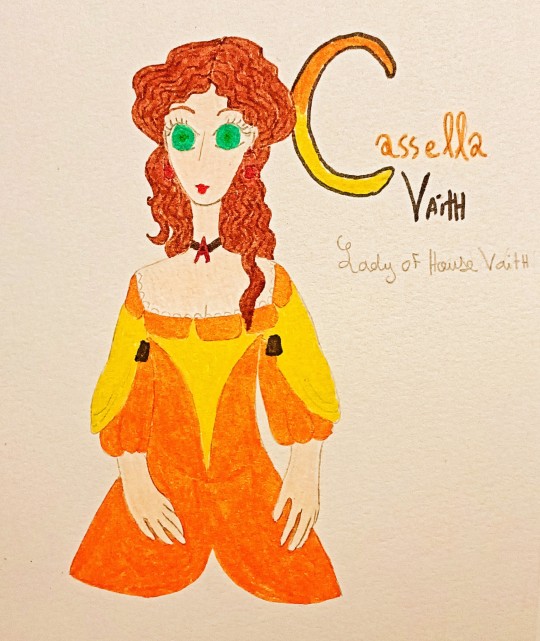
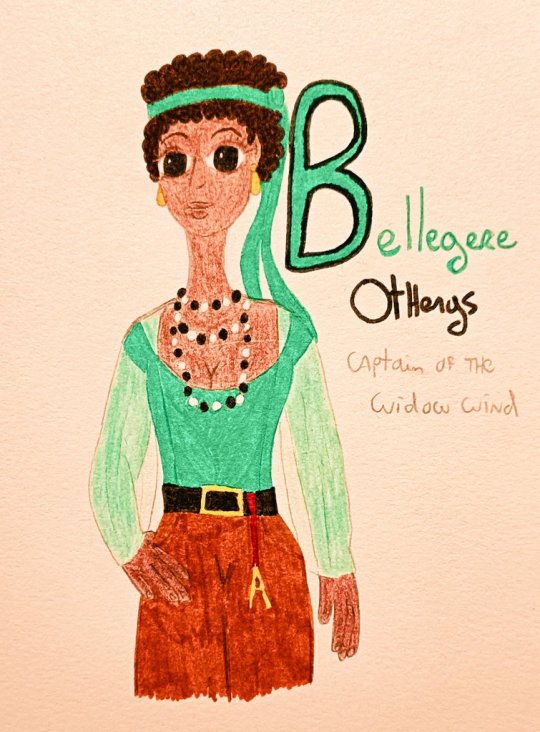




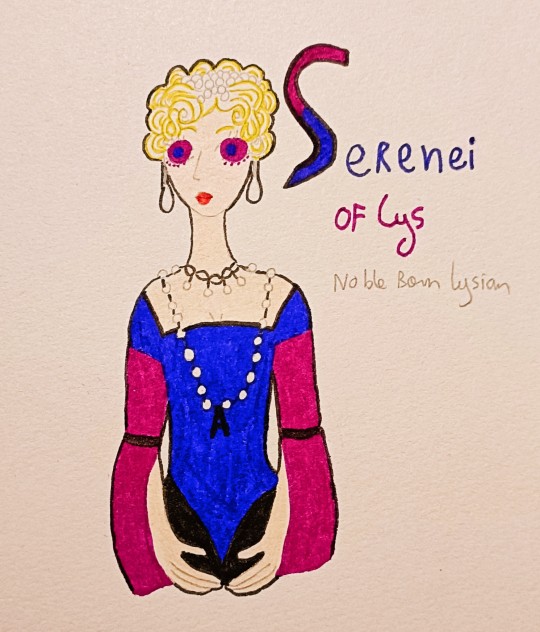

The position of the letter "A" on these ladies is important as to what relationship they had with Aegon.
Falena's is on display on a pretty ornate necklace but also half-hidden by her bodice - a sign of both pride and of an attempt at discretion.
Megette's is on her belt - quasi a sign of possession on Aegon's part ; it's also on her belly (and Megette is the woman who gave him the most children). That relationship was probably one of the most unequal he had, since she wasn't a noble and was kept by him in a place, until she was sent away by Viserys.
Cassella's in on a choker around her neck - this relationship was also unequal and possibly non consenting, since she was a hostage at court and he kept her in his own chambers. Cassella came back traumatized from the experience and seemed to have been mad and delusional for the rest of her life. So a relationship that "chocked" her.
Completely different for Bellegere Otherys ; she wasn't a court mistress but an independant woman with a ship and a business, and she had other lovers besides Aegon - so the letter "A" is set on a necklace that hangs from her belt, showing her casual attitude to him.
Both Barba Bracken and Melissa Blackwood wear it around their neck, but around a loose string : they are openly royal mistresses and have a relative control over their position (it doesn't choke them).
Bethany Blackwood's is on a necklace close to her neck, with several string. Bethany was groomed into her position and had great expectations put on her, and she ultimately tried to get free when she had her affair with the kingsguard Terence Toyne. Her necklace represents that relation she didn't want and which emprisoned and chafed her.
Jeyne Lothston was also a pretty young girl when she became Aegon's mistress (she was fourteen), and there are some disturbing things about this, like the possibility that he was her father (by his first mistress Falena Stokeworth), and even that Aegon bedded the both of them together. So the "A" letter is very close to her throat,hanging from a collar that is tight around it, and accompanied by the same bat brooch her mother wore.
Serenei of Lys' necklace with the "A" is rather loose and falls on her stomach : Serenei is a woman in control of her relationship and not "chocked" by it (she was also thought to be older than Aegon & a sorceress like her daughter Shiera) - but she does die in childbirth as a result of the relationship.
#aegon the unworthy#valyrianscrolls#royal mistress#falena stokeworth#megette#cassella vaith#bellegere otherys#barba bracken#melissa blackwood#bethany bracken#jeyne lothston#serenei of lys#house targaryen#asoiaf art#fanart
16 notes
·
View notes
Text
Fire and Blood Hotake: Danelle Lothston
Danelle Lothston most definitely had a Tully mother or father, which in turn explains her red hair. I mean i suppose it make sense since her parent(the one who she inherited Harrenhall from) would marry a Tully considering Harrenhall is one of the biggest and most powerful castles, politically and military wise as well.
This is of course is my own theory untill Fire and Blood Part 2 comes out and says something else.

#danelle lothston#harrenhall#fire and blood#House Tully#asoiaf#asoiaf art#asoiaf theories#asoiaf thoughts#blackfyre rebellion#harrenhal
6 notes
·
View notes